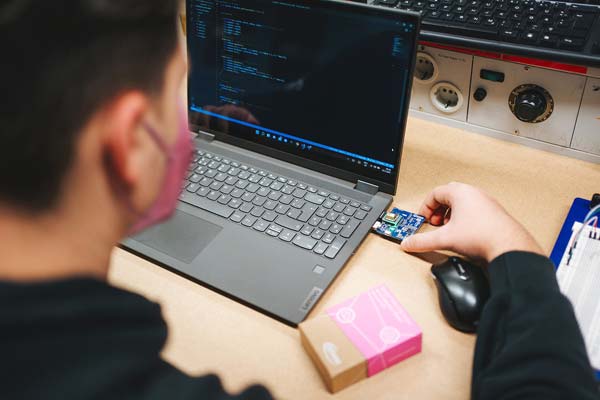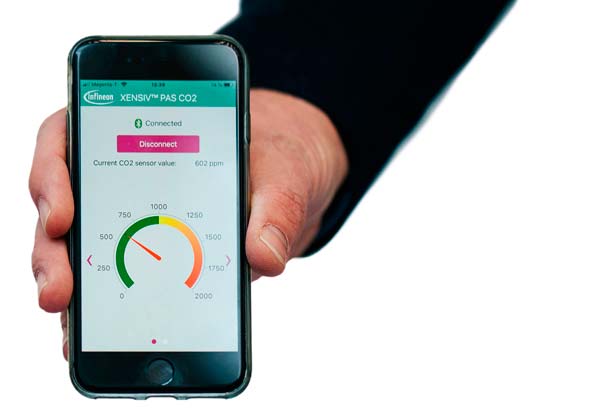 Five Higher Technical Schools (Höhere Technische Lehranstalten, HTLs) in Carinthia and six in Tyrol received high-precision CO 2 sensors from Infineon Technologies Austria AG and MCI in Innsbruck. The teams of students will use them to build CO 2 alarm lights to indicate the necessity for ventilation thus reducing the risk of infection. A total of 300 classrooms will be equipped.
Five Higher Technical Schools (Höhere Technische Lehranstalten, HTLs) in Carinthia and six in Tyrol received high-precision CO 2 sensors from Infineon Technologies Austria AG and MCI in Innsbruck. The teams of students will use them to build CO 2 alarm lights to indicate the necessity for ventilation thus reducing the risk of infection. A total of 300 classrooms will be equipped.
Indoor CO 2 levels are an important indicator of air quality. Particularly in the current pandemic, this value can help contain the spread of viruses. Regular cross-ventilation and shock-ventilation of classrooms – in addition to ongoing testing and mask-wearing – is therefore also included in the specifications of the Austrian Ministry of Education. But when is it time to ventilate? To clarify this question, Infineon and the MCI are providing the CO 2 sensor kits free of charge to eleven technical teaching institutions in Carinthia and Tyrol in order to use state-of-the-art technology to draw attention to the need for timely ventilation in the classroom.
Creating a benefit with education and know-how
In the spirit of “learning by doing”, the young technical talents use Infineon’s sensors to build their own air quality measurement systems that warn of excessive CO 2 concentrations and thus reduce the risk of virus transmission. Learning in a healthy indoor environment is of paramount importance, especially in times like these.
“With our initiative we want to support the young talents in their technology education and enable a healthy learning atmosphere in the classroom,” said Sabine Herlitschka, CEO Infineon Austria. “The students as well as the teachers are actively involved, they can combine the knowledge of several subjects – from electronics, computer science to physics – and link this to health-related topics. This encourages participation, strengthens team spirit and creates digital solutions with a benefit for the entire school.”
Precise sensor measures air quality and saves energy
 At the heart of the CO 2 sensor is an Infineon module based on XENSIV PAS technology. It measures the CO 2 content precisely, reliably and continuously. In addition, other parameters such as temperature, humidity and air pressure are measured. As soon as a threshold value is exceeded, an alarm can be triggered via a CO 2 alarm light. According to the Austrian Ministry of the Environment, the CO 2 concentration in classrooms should not exceed an average of 1,000 ppm (parts per million, i.e. 0.1 percent by volume). Since the concentration of aerosols through which the virus is transmitted correlates with the concentration of CO 2, the CO 2 sensor can help ensure that people can meet in safe indoor-conditions – whether in the office, at school or at home.
At the heart of the CO 2 sensor is an Infineon module based on XENSIV PAS technology. It measures the CO 2 content precisely, reliably and continuously. In addition, other parameters such as temperature, humidity and air pressure are measured. As soon as a threshold value is exceeded, an alarm can be triggered via a CO 2 alarm light. According to the Austrian Ministry of the Environment, the CO 2 concentration in classrooms should not exceed an average of 1,000 ppm (parts per million, i.e. 0.1 percent by volume). Since the concentration of aerosols through which the virus is transmitted correlates with the concentration of CO 2, the CO 2 sensor can help ensure that people can meet in safe indoor-conditions – whether in the office, at school or at home.
“We have created an easy-to-use system solution in our innovation lab, the ‘Emerging Applications Lab’, which is run jointly with Infineon, and it is already in use in twelve lecture halls in Innsbruck,” said MCI Rector Andreas Altmann. “Another 50 lecture hall systems are in preparation. With the display of the CO 2 value, we have an objective benchmark for the energy-efficient supply of fresh air, can ventilate according to demand and avoid unnecessary energy losses, especially during the winter season. We are happy to pass on this developer and user know-how to the schools.”
STEM talents and schools network
At school, the students learn to build and program a CO 2 alarm light under the guidance of the teachers. This allows them to deepen their hardware and software knowledge, create a digital design with LEDs and acoustic signals, control the system and expand it to an Internet-of-Things platform. To this end, a dedicated developer forum was set up across the schools to network, share knowledge and develop ideas for further innovations. Digital technologies thus offer real added value for education and collaboration.
Smart building management at HTL Villach
The school team at HTL Villach is going one step further: the CO 2 sensors are not only being used in the classes, but are also to be integrated into the technology of the building refurbishment currently underway. Combining them with the infrastructure control concept will enable automated and continuous data collection and data evaluation for the entire school. For example, noise levels could also be measured in the future. This practical collaboration between industry and education shows how STEM subjects (Science, Technology, Engineering, and Mathematics) can be used to create smart solutions for topics at the cutting edge of technology. Thus, it is an active contribution to practice-oriented education, as well as to qualified technical specialists in the region.
About MCI | The Entrepreneurial School ®
MCI | The Entrepreneurial School ® combines elements and features of universities, business schools, grande écoles, universities of applied sciences, business and consulting. With its unique concept, it stands for science, studies and advanced education, for internationality, quality, innovation, practice orientation, cooperation with business and industry, solution-oriented research and development, top infrastructure, customer and service orientation and international renown. Since 2016, Infineon has been operating the “Emerging Applications Lab” in cooperation with MCI. In this innovation lab, Infineon sensors are used to develop so-called system demonstrators, which are used, for example, for motor controls in collaborative robotics or high-frequency power electronics with gallium nitride semiconductors. For more information please refer to www.mci.edu


